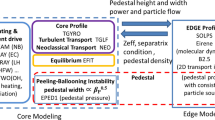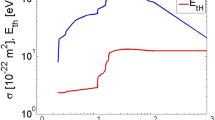Abstract
Several attempts to model the entire plasma cross section have been reported in the last few years. Two possibilities are to either couple a core code to a scrape-off layer (SOL) code at a specified interface or to extend the computational region of an SOL-code all the way to the plasma centre. The most advanced global code is the code COCONUT which is based on the former principle and comprises the Monte-Carlo code NIMBUS, the 2D scrape-off layer code EDGE2D, the core transport code JETTO and the core impurity transport code SANCO. A main feature of COCONUT is its modular structure which ensures a high degree of flexibility and the capability to cover a large range of time-scales. The influence of the SOL on the core is lllustrated with a range of global simulations carried out with COCONUT. The simulations show that the primary effect of the SOL is the control of the particle sources and sinks with a secondary effect on plasma dilution, radiation and perhaps pedestal temperatures.
Similar content being viewed by others
References
R. Zagorski et al.: Contrib. Plasma Phys. 36, 145 (1996)
J. Mandrekas et al.: Contrib. Plasma Phys. 38, 267 (1998)
D.P. Coster et al.: J. Nucl. Mat. 241–243, 690 (1997).
M. Baelmans et al.: 22nd EPS Conf., 19C-IV-321 (1995).
A. Tarditi et al.: Contrib. Plasma Phys. 36, 132 (1996)
M. Erba et al.: Plasma Phys. Control. Fusion 39, 261 (1997).
A. Taroni and The JET Team: Proc. 16th IAEA Fusion Energy Conference, Montreal (Canada) IAEA-CN-64/D3-3 (1996).
H.P. Summers: JET-IR (94)06 (1994)
R. Simonini et al.: Contrib. Plasma Phys. 34, 368 (1994).
M. Fichtmüller, G.J. Radford: JET Report JET-R(97)05 (1997).
M. Fichtmüller et al.: Contrib. Plasma Phys. 38, 284 (1998).
G.J. Radford et al.: Contrib. Plasma Phys. 36, 187 (1996).
E. Cupini et al.: NET Report, EUR XII-324/9 (1984)
L. Lauro-Taroni et al.: Contrib. Plasma Phys. 38, 242 (1998).
M. Fichtmüller et al.: to appear in J. Nucl. Mat.
D. Reiter et al.: Nucl. Fusion 30, 2141 (1990).
A. Taroni et al.: Contrib. Plasma Phys. 37, 242 (1998).
Author information
Authors and Affiliations
Rights and permissions
About this article
Cite this article
Fichtmüller, M., Corrigan, G., Lauro-Taroni, L. et al. Core-edge coupling and the effect of the EDGE on overall plasma performance. Czech J Phys 48 (Suppl 2), 25–38 (1998). https://doi.org/10.1007/s10582-998-0018-8
Issue Date:
DOI: https://doi.org/10.1007/s10582-998-0018-8




